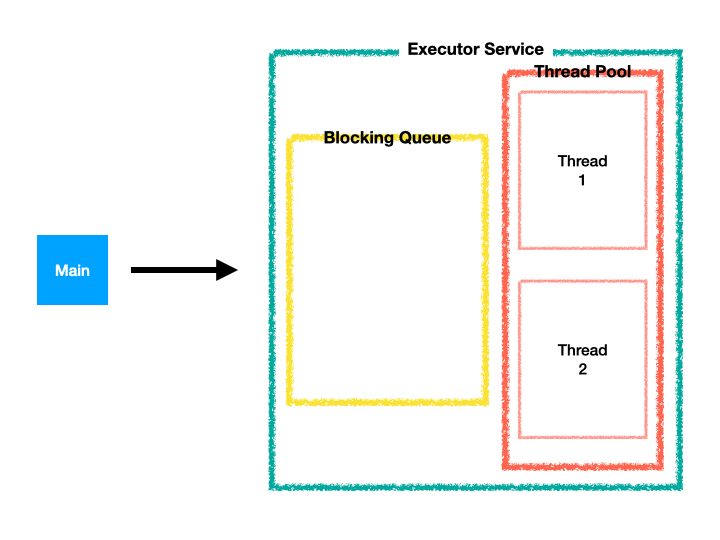Concurrency API Summary
- 기존에 병렬 처리를 하기 위해서는 Thread 클래스 혹은 Runnable 인터페이스를 직접 사용해야 했습니다. 하지만 자바 5부터 새롭게 추가된 Concurrency API를 통해 기존의 한계점을 극복합니다.
- 작업을 실행하기 위해
Executor인터페이스를 제공합니다.
- 쓰레드 풀, 큐 등 다양한 Executor 구현체를 제공합니다.
예시로 설명하는 기존 방식의 한계점 (Thread, Runnable)
웹 서버는 여러 사용자의 요청을 동시에 처리해야 하므로 다음과 같은 형태의 코드를 지닐 것입니다.
try (ServerSocket listenSocket = new ServerSocket(port)) {
Socket connection;
while ((connection = listenSocket.accept()) != null) {
Thread thread = new Thread(new RequestHandler(connection));
thread.start();
}
}문제점
- 무한히 생성되는 쓰레드
쓰레드 개수의 제한이 없기 때문에 사용자 요청이 많아지면 OOM이 발생할 수 있습니다. 따라서 최대로 생성될 수 있는 쓰레드 개수를 제한할 수 있어야 합니다.
- 쓰레드 생성&종료
모든 요청에 대해 쓰레드를 새로 생성&종료하여 오버헤드가 발생합니다. 따라서 쓰레드를 재사용 한다면 부하를 줄일 수 있습니다.
- 값의 반환 불가능
Executor

- 개발자가 하나하나 Thread를 관리하기 힘듭니다.
- 따라서 쓰레드를 만들고 관리하는 작업을
Executor에게 위임합니다.
- 생성 : application에서 사용될 Thread를 만들거나, 쓰레드 풀을 통해 관리합니다.
- 관리 : Thread 생명 주기 관리
- 작업 처리 및 실행 : Thread로 작업을 수행하기 위한 API 제공
Example
execute(Runnable),submit(Runnable)⇒ 쓰레드 작업 수행
shutdown()⇒ 할 일을 마치고 종료
shutdownNow()⇒ 즉시 종료
그 외의 주요 인터페이스
Executors
- 직접 쓰레드를 다루는 것은 번거로운데, 이를 도와주는 팩토리 역할을 합니다.
- Executor, ExecutorService, SchedueledExecutorService를 구현한 쓰레드 풀을 손쉽게 생성합니다.
- 쓰레드 풀을 return 합니다.
Example
newFixedThreadPool()- 고정된 쓰레드의 개수를 갖는 쓰레드 풀을 생성합니다.
- ExecutorService 인터페이스를 구현한 ThreadPoolExecutor 객체가 생성됩니다.
newCachedThredPool()- 필요할 때 필요한 만큼의 쓰레드를 풀 생성합니다. (고정X)
- 이미 생성된 쓰레드가 있다면 이를 재활용 할 수 있습니다.
- 60초 동안 사용되지 않으면 쓰레드를 종료시킵니다.
newworkstealingpool()- 인자를 통해 병렬 처리 레벨을 지정합니다.
- 인자를 지정하지 않으면 현재 시스템의 core 프로세스 개수 기반으로 pool 사이즈가 할당됩니다.
ExecutorService

Executor인터페이스를 상속 받은 인터페이스
Runnable,Callable실행 가능
- 작업 등록 뿐 아니라 실행의 책임도 갖음
import java.util.concurrent.ExecutorService;
import java.util.concurrent.Executors;
public class ExecutorTest {
public static void main(String[] args) {
// given
ExecutorService executorService = Executors.newFixedThreadPool(4);
// when
executorService.submit(getRunnable("test1"));
executorService.submit(getRunnable("test2"));
executorService.submit(getRunnable("test3"));
executorService.submit(getRunnable("test4"));
executorService.submit(getRunnable("test5"));
executorService.shutdown();
}
private static Runnable getRunnable(String message){
return () -> System.out.println(Thread.currentThread().getName() + " :: " + message);
}
}pool-1-thread-1 :: test1
pool-1-thread-4 :: test4
pool-1-thread-2 :: test2
pool-1-thread-3 :: test3
pool-1-thread-2 :: test5
BUILD SUCCESSFUL in 164ms
ScheduledExecutorService
ExecutorService를 상속받은 인터페이스
- 특정 시간 이후 또는 주기적으로 작업을 수행하게 하는 스케줄 기능
import java.util.concurrent.ExecutorService;
import java.util.concurrent.Executors;
import java.util.concurrent.ScheduledExecutorService;
import java.util.concurrent.TimeUnit;
public class ExecutorTest {
public static void main(String[] args) {
ScheduledExecutorService executorService = Executors.newSingleThreadScheduledExecutor();
executorService.scheduleAtFixedRate(getRunnable("Test"), 1, 2, TimeUnit.SECONDS);
}
private static Runnable getRunnable(String message){
return () -> System.out.println(Thread.currentThread().getName() + " :: " + message);
}
}pool-1-thread-1 :: Test
pool-1-thread-1 :: Test
pool-1-thread-1 :: Test
pool-1-thread-1 :: Test
pool-1-thread-1 :: TestscheduleAtFixedRate()함수 원형public ScheduledFuture<?> scheduleAtFixedRate(Runnable command, long initialDelay, long period, TimeUnit unit);- initialDelay 후에 period 간격으로 command를 run()하겠다!
- 명시적으로 종료시켜 주어야 함
Callable
public interface Callable<V> {
V call() throws Exception;
}Runnable과 같이 쓰레드 생성에 사용되는 인터페이스
- return type이 객체이기 때문에 처리 결과를 받을 수 있음
Runnable과 Callable의 차이점
Runnable⇒ 반환 타입 없어서 처리 결과 받을 수 없음,public interface Runnable { public abstract void run(); }
Callable⇒ 반환 타입이 객체여서 처리 결과 받을 수 있음, 메소드 수행 중 Exception 던지기 가능
Future
- 비동기 작업의 현재 상태를 조회하거나 결과를 가져오기 위한 객체
- Runnable, Callable의 상태를 조회하거나 결과를 확인함
- 시간이 걸리는 작업의 결과를 기다리는 동안 다른 작업을 할 수 있음
- 시간이 걸리는 작업은 Callable에 작성
- submit 후 Future 객체 저장
- 다른 작업 수행
get()호출을 통해 블로킹(Blocking) 콜을 수행 ⇒ 결과 확인을 위해 기다린다.
import java.util.concurrent.*; public class ExecutorTest { public static void main(String[] args) throws ExecutionException, InterruptedException { ExecutorService executorService = Executors.newSingleThreadExecutor(); // 시간이 걸리는 작업 수행 Future<String> future = executorService.submit(getCallable()); // 다른 작업 수행 System.out.println(future.isDone()); System.out.println("다른 작업 수행"); // 블로킹 콜 future.get(); System.out.println(future.isDone()); System.out.println("Finish"); executorService.shutdown(); } private static Callable getCallable(){ return () -> { Thread.sleep(2000L); return "Sleep finish"; }; } }
- invokeAll()
- 동시에 실행한 작업 중 제일 오래 걸리는 작업이 끝나야 결과 반환
- 모든 결과가 수행된 뒤 처리 되어야 할 때 사용
import java.util.*; import java.util.concurrent.*; public class ExecutorTest { public static void main(String[] args) throws ExecutionException, InterruptedException { ExecutorService executorService = Executors.newSingleThreadExecutor(); Callable<String> callable1 = () -> { Thread.sleep(1000L); return "Hello1"; }; Callable<String> callable2 = () -> { Thread.sleep(2000L); return "Hello2"; }; Callable<String> callable3 = () -> { Thread.sleep(3000L); return "Hello3"; }; List<Future<String>> futures = executorService.invokeAll(Arrays.asList(callable1, callable2, callable3)); for(Future<String> future : futures){ System.out.println(future.get()); } executorService.shutdown(); } private static Callable getCallable(long time){ return () -> { Thread.sleep(time); return "Sleep finish"; }; } }
Reference.
https://www.geeksforgeeks.org/java-util-concurrent-package/
http://javacan.tistory.com/124
https://velog.io/@neity16/Java-8-4-자바-Concurrent-Executors-Callable-Future

